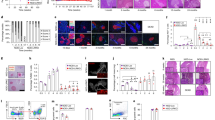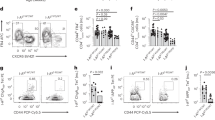Abstract
The progression of autoimmune diabetes is regulated. We examined here the cellular controls exerted on disease that developed in the BDC2.5 T cell receptor–transgenic model. We found that all BDC2.5 mice with a monoclonal, β cell–reactive, T cell repertoire developed diabetes before 4 weeks of age; transfer of splenocytes from young standard NOD (nonobese diabetic) mice into perinatal monoclonal BDC2.5 animals protected them from diabetes. The protective activity was generated by CD4+ αβ T cells, which operated for a short time at disease initiation, could be partitioned according to DX5 cell surface marker expression and split into two components. Protection did not involve clonal deletion or anergy of the autoreactive BDC2.5 cells, permitting their full activation and attack of pancreatic islets; rather, it tempered the aggressiveness of the insulitic lesion and the extent of β cell destruction.
This is a preview of subscription content, access via your institution
Access options
Subscribe to this journal
Receive 12 print issues and online access
$209.00 per year
only $17.42 per issue
Buy this article
- Purchase on Springer Link
- Instant access to full article PDF
Prices may be subject to local taxes which are calculated during checkout








Similar content being viewed by others
References
Katz, J. D., Wang, B., Haskins, K., Benoist, C. & Mathis, D. Following a diabetogenic T cell from genesis through pathogenesis. Cell 74, 1089–1100 (1993).
Haskins, K., Portas, M., Bergman, B., Lafferty, K. & Bradley, B. Pancreatic islet-specific T-cell clones from nonobese diabetic mice. Proc. Natl Acad. Sci. USA 86, 8000–8004 (1989).
Gonzalez, A. et al. Genetic control of diabetes progression. Immunity 7, 873–883 (1997).
Luhder, F., Höglund, P., Allison, J. P., Benoist, C. & Mathis, D. Cytotoxic T lymphocyte-associated antigen 4 regulates the unfolding of autoimmune diabetes. J. Exp. Med. 187, 427–432 (1998).
André-Schmutz, I., Hindelang, C., Benoist, C. & Mathis, D. Cellular and molecular changes accompanying the progression from insulitis to diabetes. Eur. J. Immunol. 29, 245–255 (1999).
Verdaguer, J. et al. Spontaneous autoimmune diabetes in monoclonal T cell nonobese diabetic mice. J. Exp. Med. 186, 1663–1676 (1997).
Luhder, F., Chambers, C., Allison, J. P., Benoist, C. & Mathis, D. Pinpointing when T cell costimulatory receptor CTLA-4 must be engaged to dampen diabetogenic T cells. Proc. Natl Acad. Sci. USA 97, 12204–12209 (2000).
Balasa, B., Van Gunst, K. & Sarvetnick, N. The microbial product lipoploysaccharide confers diabetogenic potential on repertoire of BDC2. 5/NOD mice: implications for the etiology of autoimmunity. Clin. Immunol. 95, 93–98 (2000).
Horwitz, M. S. et al. Diabetes induced by Coxsackie virus: initiation by bystander damage and not molecular mimicry. Nature Med. 4, 781–785 (1998).
Groux, H. & Powrie, F. Regulatory T cells and inflammatory bowel disease. Immunol. Today 20, 442–445 (1999).
Sakaguchi, S. Regulatory T cells: key controllers of immunologic self-tolerance. Cell 101, 455–458 (2000).
Godfrey, D. I., Hammond, K. J., Poulton, L. D., Smyth, M. J. & Baxter, A. G. NKT cells: facts, functions and fallacies. Immunol. Today 21, 573–583 (2000).
Roncarolo, M.-G. & Levings, M. K. The role of different subsets of T regulatory cells in controlling autoimmunity. Curr. Opin. Immunol. 12, 676–683 (2000).
Waldmann, H. & Cobbold, S. Regulating the immune response to transplants: a role for CD4+ regulatory cells? Immunity 14, 399–406 (2001).
Mombaerts, P. et al. RAG-1-deficient mice have no mature B and T lymphocytes. Cell 68, 869–877 (1992).
Höglund, P., Mintern, J., Heath, W., Benoist, C. & Mathis, D. Initiation of autoimmune diabetes by developmentally regulated presentation of islet cell antigens in the pancreatic lymph nodes. J. Exp. Med. 189, 331–339 (1999).
Wang, B., Gonzalez, A., Benoist, C. & Mathis, D. The role of CD8+ T cells in initiation of insulin-dependent diabetes mellitus. Eur. J. Immunol. 26, 1762–1769 (1996).
Goldrath, A. W. & Bevan, M. J. Selecting and maintaining a diverse T-cell repertoire. Nature 402, 255–262 (1999).
Surh, C. D. & Sprent, J. Homeostatic T cell proliferation. How far can T cells be activated to self-ligands? J. Exp. Med. 192, 9–14 (2000).
Carnaud, C., Gombert, J., Donnars, O., Garchon, H. & Herbelin, A. Protection against diabetes and improved NK/NKT cell performance in NOD. NK1. 1 mice congenic at the NK complex. J. Immunol. 166, 2404–2411 (2001).
Arase, H., Saito, T., Philips, J. H. & Lanier, L. L. The mouse NK cell-associated antigen recognized by DX5 monoclonal antibody is CD49b (α2 integrin, very late antigen-2). J. Immunol. 167, 1141–1144 (2001).
Fritz, R. B. & Zhao, M. L. Regulation of experimental autoimmune encephalomyelitis in the C57BL/6J mouse by NK1.1+, DX5+, αβ+ T cells. J. Immunol. 166, 4209–4215 (2001).
Slifka, M. K., Pagarigan, R. R. & Whitton, J. L. NK markers are expressed on a high percentage of virus-specific CD8+ and CD4+ T cells. J. Immunol. 164, 2009–2015 (2000).
Wang, B. et al. Interleukin-4 deficiency does not worsen disease in NOD mice. Diabetes 47, 1207–1211 (1998).
Kuhn, R., Lohler, J., Rennick, D., Rajewsky, K. & Muller, W. Interleukin-10-deficient mice develop chronic enterocolitis. Cell 75, 263–274 (1993).
Kurrer, M. O., Pakala, S. V., Hanson, H. L. & Katz, J. D. B cell apoptosis in T cell-mediated autoimmune diabetes. Proc. Natl Acad. Sci. USA 94, 213–218 (1997).
Olivares-Villagomez, D., Wang, Y. & Lafaille, J. J. Regulatory CD4(+) T cells expressing endogenous T cell receptor chains protect myelin basic protein-specific transgenic mice from spontaneous autoimmune encephalomyelitis. J. Exp. Med. 188, 1883–1894 (1998).
Olivares-Villagomez, D., Wensky, A. K., Wang, Y. & Lafaille, J. Repertoire requirements of CD4+ T cells that prevent spontaneous autoimmune encephalomyelitis. J. Immunol. 164, 5499–5507 (2000).
Luhder, F., Katz, J., Benoist, C. & Mathis, D. MHC class II molecules can protect from diabetes by positively selecting T cells with additional specificities. J. Exp. Med. 187, 379–387 (1998).
Salomon, B. et al. B7/CD28 Costimulation is Essential for the Homeostasis of the CD4+CD25+ Immunoregulatory T Cells that Control Autoimmune Diabetes. Immunity 12, 431–440 (2000).
Lepault, F. & Gagnerault, M. C. Characterization of peripheral regulatory CD4+ T cells that prevent diabetes in nonobese diabetic mice. J. Immunol. 164, 240–247 (2000).
Baxter, A. G., Kinder, S. J., Hammond, K. J. L., Scollay, R. & Godfrey, D. I. Association between αβTCR+CD4−CD8− T-cell deficiency and IDDM in NOD/Lt mice. Diabetes 46, 572–582 (1997).
Lehuen, A. et al. Overexpression of natural killer T cells protects Vα14-Jα281 transgenic nonobese diabetic mice against diabetes. J. Exp. Med. 188, 1831–1839 (1998).
Shi, F. D. et al. Germ line deletion of the CD1 locus exacerbates diabetes in the NOD mouse. Proc. Natl Acad. Sci. USA 98, 6777–6782 (2001).
Hammond, K. J. et al. NKT cells are phenotypically and functionally diverse. Eur. J. Immunol. 29, 3768–3781 (1999).
Ortaldo, J. R., Winkler-Pickett, R., Mason, A. T. & Mason, L. H. The Ly-49 family: regulation of cytotoxicity and cytokine production murine CD3+ cells. J. Immunol. 160, 1158–1165 (1998).
Moodycliffe, A. M., Maiti, S. & Ullrich, S. E. Splenic NK1. 1−, TCR αβ intermediate CD4+ T cells exist in naive NK1. 1 allelic positive and negative mice, with the capacity to rapidly secrete large amounts of IL-4 and IFN-γ upon primary TCR stimulation. J. Immunol. 162, 5156–5163 (1999).
Behar, S. M. & Cardell, S. Diverse CD1d-restricted T cells: diverse phenotypes, and diverse functions. Semin. Immunol. 12, 551–560 (2000).
Gombert, J. M. et al. Early quantitative and functional deficiency of NK1+-like thymocytes in the NOD mouse. Eur. J. Immunol. 26, 2989–2998 (1996).
Poulton, L. D. et al. Cytometric and functional analyses of NK and NKT cell deficiency in NOD mice. Int. Immunol. 13, 887–896 (2001).
Read, S., Malmstrom, V. & Powrie, F. Cytotoxic T lymphocyte-associated antigen 4 plays an essential role in function of CD25(+)CD4(+) regulatory cells that control intestinal inflammation. J. Exp. Med. 192, 295–302 (2000).
Takahashi, T. et al. Immunologic self-tolerance maintained by CD25(+)CD4(+) regulator cells constitutively expressing cytotoxic T lymphocyte-associated antigen. J. Exp. Med. 192, 303–310 (2000).
Ludewig, B. et al. Immunotherapy with dendritic cells directed against tumor antigens shared with normal host cells results in severe autoimmune disease. J. Exp. Med. 191, 795–804 (2000).
Itoh, M. et al. Thymus and autoimmunity: production of CD25+CD4+ naturally anergic and suppressive T cells as a key function of the thymus in maintaining immunologic self-tolerance. J. Immunol. 162, 5317–5326 (1999).
Thornton, A. M. & Shevach, E. M. CD4+CD25+ immunoregulatory T cells suppress polyclonal T cell activation in vitro by inhibiting interleukin 2 production. J. Exp. Med. 188, 287–296 (1998).
Benoist, C. & Howard, M. Editorial overview. Curr. Opin. Immunol. 12, 661–663 (2001).
Stockinger, B., Barthlott, T. & Kassiotis, G. T cell regulation: a special job or everyone's responsibility? Nature Immunol. 2, 757 (2001).
hilpott, K. L. et al. Lymphoid development in mice congenitally lacking T cell receptor αβ-expressing cells. Science 256, 1448–1452 (1992).
Kouskoff, V. et al. Organ-specific disease provoked by systemic autoreactivity. Cell 87, 811–822 (1996).
Katz, J., Benoist, C. & Mathis, D. Major histocompatibility complex class I molecules are required for the development of insulitis in non-obese diabetic mice. Eur. J. Immunol. 23, 3358–3360 (1993).
Chan, S. H., Cosgrove, D., Waltzinger, C., Benoist, C. & Mathis, D. Another view of the selective model of thymocyte selection. Cell 73, 225–236 (1993).
Openshaw, P. et al. Heterogeneity of intracellular cytokine synthesis at the single-cell level in polarized T helper 1 and T helper 2 populations. J. Exp. Med. 182, 1357–1367 (1995).
Acknowledgements
We thank L. Lanier, K. Rajewsky, F. Luhder and P. Hoglund for reagents and discussion; C. Waltzinger and C. Ebel for cell sorting; T. Ding for histology; and P. Michel and M. Gendron for maintaining the mice. Supported by institute funds from the INSERM, the CNRS, the Hopital Universitaire de Strasbourg and the Juvenile Diabetes Foundation International (A. G.).
Author information
Authors and Affiliations
Corresponding author
Rights and permissions
About this article
Cite this article
Gonzalez, A., Andre-Schmutz, I., Carnaud, C. et al. Damage control, rather than unresponsiveness, effected by protective DX5+ T cells in autoimmune diabetes. Nat Immunol 2, 1117–1125 (2001). https://doi.org/10.1038/ni738
Received:
Accepted:
Published:
Issue Date:
DOI: https://doi.org/10.1038/ni738
This article is cited by
-
Mesenchymal stem cells attenuate ischemic acute kidney injury by inducing regulatory T cells through splenocyte interactions
Kidney International (2013)
-
Identification of CD3 + CD4 − CD8 − T Cells as Potential Regulatory Cells in an Experimental Murine Model of Graft-Versus-Host Skin Disease (GVHD)
Journal of Investigative Dermatology (2013)
-
DX5+NKT cells display phenotypical and functional differences between spleen and liver as well as NK1.1-Balb/c and NK1.1+ C57Bl/6 mice
BMC Immunology (2011)
-
Regulatory T cells in experimental autoimmune disease
Springer Seminars in Immunopathology (2006)
-
Regulatory T cells under scrutiny
Nature Reviews Immunology (2003)



